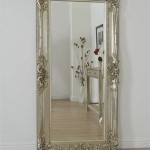How To Tell If A Mirror Is Two-Way
Two-way mirrors, also known as observation mirrors or one-way mirrors, appear reflective on one side but transparent on the other, allowing discreet observation. Distinguishing a standard mirror from a two-way mirror can be crucial for privacy and security. Several methods can help determine the nature of a mirror's reflectivity.
The Observation Test
This method relies on the principle of differential lighting. A two-way mirror relies on a difference in light levels between the two sides. The observation side must be significantly darker than the mirrored side for the effect to work. If the lighting is similar on both sides, the mirror becomes more transparent. To perform this test, darken the room where the suspected two-way mirror is located. Then, shine a bright light directly onto the mirror's surface. If it's a two-way mirror, the observer will be able to see through the mirror into the darkened room.
It is important to note that this method is not foolproof. If the observation room is very dark, or the reflective coating on the mirror is especially thick, even a bright light may not reveal what lies behind. Therefore, it's advisable to combine this test with other methods for a more accurate assessment.
The Fingernail Test
The fingernail test is a simple, albeit less reliable, method for assessing a mirror. Place the tip of your fingernail against the surface of the mirror. With a standard, second-surface mirror, a small gap will appear between your fingernail and its reflection due to the layer of glass in front of the reflective coating. With a two-way mirror, or a first-surface mirror, your fingernail and its reflection will appear to touch directly, with no noticeable gap. This is because the reflective coating is on the front surface of the glass.
This method can be misleading. The quality and manufacturing of the mirror can influence the apparent gap. Some second-surface mirrors might have a very thin layer of glass, making the gap difficult to see. Conversely, dirt or grime on a two-way mirror could create the illusion of a gap. Thus, this test should be used in conjunction with other methods for greater certainty.
The Sound Test
This method leverages the principle of sound transmission. A standard second-surface mirror, with its thicker layer of glass, will absorb and reflect more sound than a two-way mirror. To perform the sound test, gently knock on the surface of the mirror. A standard mirror will produce a dull, muted thud. A two-way mirror, being thinner, will often produce a brighter, more hollow sound. The sound waves are passing through the thinner glass and reverberating within the observation space behind.
The effectiveness of the sound test can be affected by the surrounding environment and the mounting of the mirror. Background noise can make it difficult to discern the subtleties in sound reflection. Additionally, how the mirror is mounted to the wall can influence the sound it produces. Therefore, it's advisable to use this test in conjunction with other methods for a more comprehensive assessment.
The Deconstruction Method (If Possible)
If the situation permits and the mirror is removable, carefully taking it down can provide definitive confirmation. Examine the edges of the mirror. A second-surface mirror will typically have a backing, often made of wood or plastic, protecting the reflective coating. A two-way mirror may lack this backing, or it may have a thinner, less substantial backing. Looking through the glass from the edges can also reveal if there is an observation space behind.
This method is the most conclusive but requires access and the ability to remove the mirror without causing damage. It should be used with caution and only when appropriate. If removing the mirror is not feasible, relying on the combination of the other testing methods will provide a more reliable assessment.
Considering the Context
The location and circumstances surrounding the mirror should also be taken into account. Two-way mirrors are most commonly used in specific environments like police interrogation rooms, security observation areas, and certain research facilities. If the mirror is located in a public restroom, changing room, or other privacy-sensitive area, it's statistically less likely to be a two-way mirror. However, heightened awareness and cautious observation are always recommended in any situation where privacy is a concern.
Being aware of the potential for surveillance and understanding the methods for identifying two-way mirrors can provide valuable peace of mind and enhance personal security.

How To Tell If A Mirror Is Two Way Or Not 8 Steps With Pictures

How To Tell If A Mirror Is Two Way Or Not 8 Steps With Pictures

Women Safety Difference Between Mirror And 2 Way Glass

How To Tell If A Mirror Is Two Way Or Not 8 Steps With Pictures

No Space Leave This Place Finger Test Won T Always Tell The Difference Between Real And Two Way Mirrors Check

How To Detect A Two Way Mirror Fingernail Test

Two Way Mirror Fingernail Test

How A Two Way Mirror Works

Mirror Safety Create Space In Your Hotel Room

This Is Super Creepy I Know Will Always Check My Dressing Room Mirrors Two Way Mirror Fun Facts Useful Life S








